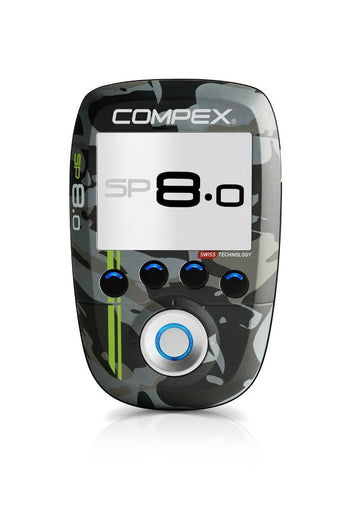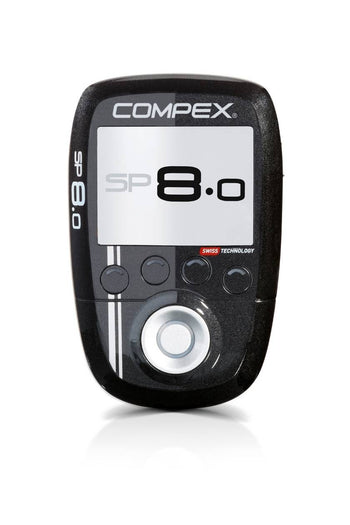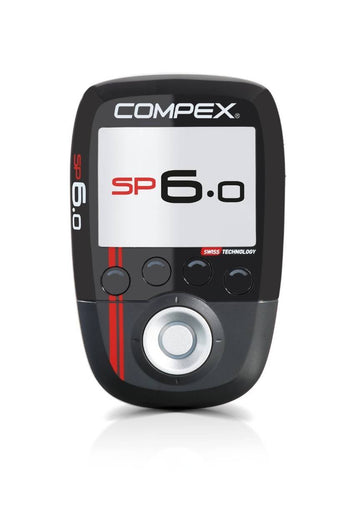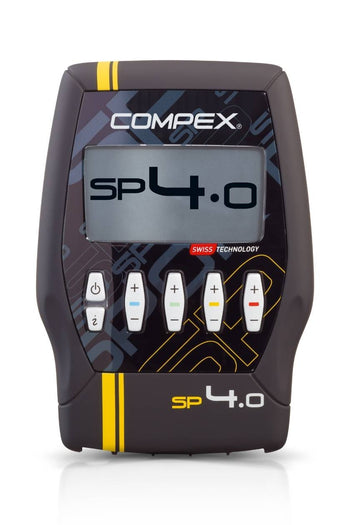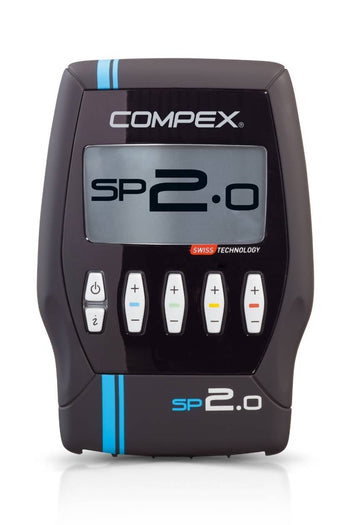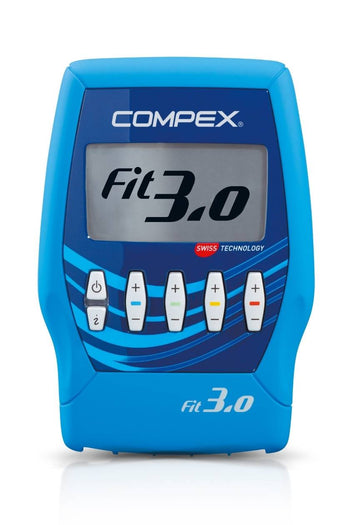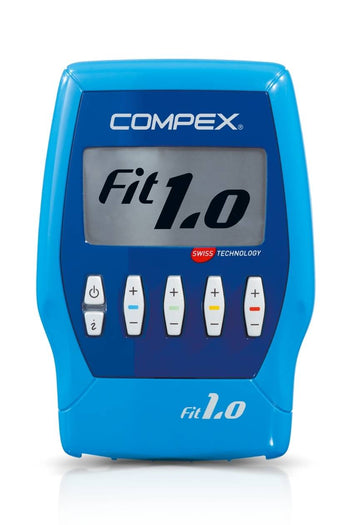Populære produkter
Compex Elektrisk Muskelstimulering (EMS) Kliniske Studier
Elektrisk muskelstimulering (EMS) er nu en anerkendt teknik, og dens effektivitet er blevet bekræftet af adskillige videnskabelige publikationer. Nogle af disse studier er blevet udført i samarbejde med Compex og fremhæver effektiviteten af EMS.
Klinisk dokumenterede Compex EMS-produkter
1. ER HØJFREKVENS NEUROMUSKULÆR ELEKTRISK STIMULATION ET EGNET VÆRKTØJ TIL FORBEDRING AF MUSKELYDELSE HOS BÅDE SUNDERE MENNESKER OG ATLETER?
Forfatter(e) og Udgivelse: Gondin et al., European Journal of Applied Physiology, okt 2011, Vol. 111(10), s. 2473-87.
I denne franske undersøgelse gennemgik forfatterne litteraturen med det formål at give et overblik over fordelene og begrænsningerne ved elektrisk muskelstimulering (EMS) hos raske personer, fritids- og konkurrenceatleter.
EMS-træning resulterer i en betydelig stigning i muskelstyrke.
Når EMS kombineres med dynamiske frivillige øvelser, kan det også forbedre sportspecifikke færdigheder og præstationer, såsom springpræstation og sprintkapacitet.
EMS er et interessant træningsværktøj for atleter, fordi de 'hurtige' muskelfibre lettere kan aktiveres ved lavere kraftniveauer under elektrisk stimulering, mens disse fibre normalt rekrutteres ved højere effektniveauer under frivillig træning.
EMS fremstår som en foretrukken metode, når den tilgængelige tid til styrketræningsprogrammet er begrænset, og det giver også variation og alsidighed i træningsprogrammet, hvilket kan øge atletens motivation.
Forfatterne konkluderer, at der er overbevisende beviser for, at elektrisk stimulation er et relevant og effektivt supplement til frivillige modstandstræningsprotokoller for forbedring af muskelstyrke, hvor maksimal frivillig kontraktion af knæekstensoren øges med op til 27 % og muskelvolumen øges med 8 % efter 8 uger. Det er også et lovligt supplement for atleter (f.eks. sammenlignet med dopingprocedurer).
2. EFFEKTER AF KOMBINERET ELEKTROMYOSTIMULATION OG GYMNASTIKTRÆNING HOS PRÆPUBERTÆRE PIGER.
Forfatter(e) og publikation: Deley et al., Journal of Strength and Conditioning Research, feb 2011, bind 25(2) s. 520-526.
Styrketræning er en vigtig træningsaspekt for gymnaster på grund af de høje eksplosive kræfter, der kræves.
I denne franske undersøgelse blev en Compex Sport-enhed brugt til at undersøge effekterne af et 6-ugers kombineret elektrisk muskelstimulering (EMS) og gymnastiktræningsprogram på muskelstyrke og vertikal springpræstation hos præpubertære gymnaster.
16 unge kvindelige gymnaster blev tilfældigt opdelt i to grupper: en gruppe modtog EMS-træning af knæekstensorerne ud over gymnastiktræningen, og den anden gruppe (kontrolgruppen) modtog kun gymnastiktræning.
Efter de første 3 uger med EMS-træning var der en betydelig stigning i muskelstyrken i knæekstensorerne samt i springpræstationen, mens kontrolgruppen ikke viste nogen ændringer i de samme parametre.
Forbedringerne i springevnen blev stadig opretholdt 1 måned efter afslutningen af EMS-træningsprogrammet.
Forfatterne foreslår at integrere kortvarig EMS-styrketræning i træningen af unge gymnaster for at forbedre styrke og springevne.
3. EFFEKTER AF ET ELEKTROSTIMULERINGSTRÆNINGSPROGRAM PÅ STYRKE, HOPPE- OG SPARKEVEDER I FODBOLDSPILLERE.
Forfatter(e) og publikation: Billot et al., Journal of Strength and Conditioning Research, maj 2010, Vol. 24(5), s. 1407-1413.
I denne franske undersøgelse blev en Compex Energy-enhed brugt til at undersøge effekten af et 5-ugers elektrostimulerings- (EMS) træningsprogram på muskelstyrke (quadriceps), sparkhastighed, sprint og vertikal springpræstation hos fodboldspillere.
20 mandlige fodboldspillere blev tilfældigt opdelt i to træningsgrupper: en gruppe (EMS-gruppen) modtog EMS på quadricepsmusklerne i 5 uger (3 sessioner af 12 minutter om ugen) samt fodboldtræning, mens den anden gruppe (kontrolgruppen) kun havde fodboldtræning.
På Compex-enheden blev programmet 'Styrke' valgt på niveau 5.
Atleterne blev testet efter 3 og 5 ugers træning, og ved begge vurderinger viste de betydelige forbedringer i quadriceps muskelstyrkeparametre samt i boldhastighedspræstation, mens disse forbedringer ikke blev observeret i kontrolgruppen.
Forfatterne anbefaler brugen af EMS som supplement til traditionel træning i fodbold, da det synes at være en levedygtig metode til at forbedre styrke og specifikke fodboldopgaver. Det kan også tilføre variation til træningsprogrammet, hvilket kan øge motivationen hos nogle spillere.
Desuden anbefaler forfatterne også brugen af det til skadede atleter for at mindske eller eliminere effekterne af træningsophør.
4. SAMMENLIGNING AF SVØMMErestitution OG MUSKELSTIMULATION PÅ LAKTATFJERNELSE EFTER SPURTSVØMNING.
Forfatter(e) og publikation: Neric et al., Journal of Strength and Conditioning Research, dec. 2009, bind 23(9) s. 2560-2567.
Konkurrencesvømning kræver flere omgange med højintensiv træning, hvilket fører til forhøjet mælkesyre i blodet. Aktiv træningsbaseret restitution har vist sig at sænke mælkesyren hurtigere end passiv hvile, men det er ikke altid praktisk muligt.
Denne californiske undersøgelse havde til formål at evaluere effekten af aktiv restitution med elektrisk stimulation versus submaksimal svømmerestitution og passiv hvile.
Blodlaktatniveauer blev målt før og umiddelbart efter en 200 yards svømmesprint, samt efter 10 min (‘midt-i-restitution’) og 20 min (‘efter-restitution’) af restitution.
Ved begge restitutionsvurderinger var blodlaktatniveauerne mest reducerede med restitutionsmetoden submaksimalt svømning. Dog gav elektrisk muskelstimulering også en signifikant bedre laktatreduktion sammenlignet med hvilerestitution.
Derfor foreslår forfatterne elektrisk stimulation som en alternativ restitutionsbehandling med det formål at sænke blodets mælkesyre. Der kan være situationer, hvor atleten har begrænset adgang til en pool, eller er fysisk eller psykisk udmattet og ikke motiveret til at fortsætte med at træne, eller simpelthen søger en alternativ restitutionsbehandling. I disse situationer kan brug af elektrisk stimulation til at fremkalde muskelkontraktioner, mens man ellers hviler, være gavnligt for at hjælpe med at reducere muskel- og blodmælkesyre før efterfølgende præstation.
5. ELEKTROMYOSTIMULERINGSEFFEKT PÅ NEURONAL STYRING OG MUSKELARKITEKTUR.
Forfatter(e) og Udgivelse: Gondin et al. Medicine & Science in Sports & Exercise, 2005, Bind 37(8) s. 1291-1299.
Med elektrisk muskelstimulering, der i vid udstrækning anvendes som en metode til styrketræning, ønskede forfatterne af denne franske undersøgelse at undersøge de tilpasninger, der sker i de muskler og nerver, der udsættes for elektrisk muskelstimulering.
Derfor delte de 20 forsøgspersoner op i en elektrostimuleret gruppe og en kontrolgruppe. EMS-gruppen gennemgik et 8-ugers EMS-træningsprogram for quadricepsmusklerne med en Compex Sport-enhed.
Den maksimale muskelstyrke blev øget med 27 % efter 8 ugers EMS-træning – mens der ikke blev noteret nogen styrkeforøgelse i kontrolgruppen.
På det neurale niveau fandt forfatterne, at EMS-træning øgede den samlede aktivitet i den stimulerede muskel: motornerverne er i stand til at aktivere flere muskelfibre med EMS.
På muskelniveau medførte EMS-træning øget quadriceps muskelmasse (målt ved musklens tværsnitsareal) og ændringer mod en mere effektiv muskelarkitektur.
Neurale tilpasninger fandt hovedsageligt sted i løbet af de første 4 ugers træning, mens muskeltilpasninger blev betydelige mellem 4 og 8 ugers træning.
Det blev konkluderet, at styrkeforøgelsen ved træning med elektrisk muskelstimulering er forbundet med både neurale og muskulære tilpasninger.
6. EFFEKTEN AF TRE FORSKELLIGE MELLEM-INNINGS RESTITUTIONSMETODER PÅ BASEBALL-KASTEPRESTATION.
Forfatter(e) og publikation: Warren et al., Journal of Strength and Conditioning Research, marts 2011, bind 25(3), s. 683-688.
I baseball (og også i andre sportsgrene) er det vigtigt at musklerne restitueres i hvileperioderne mellem de intense innings for konsekvent at kunne præstere på højeste niveau under konkurrencer.
I denne californiske undersøgelse sammenlignede forfatterne effektiviteten af tre former for restitution for at afgøre, hvilken der var mest effektiv efter en inning med pitching i baseball:
1. Passiv restitution: ingen aktivitet i 6 minutter.
2. Aktiv jogging restitution: 6 minutters jogging.
3. Aktiv EMS (elektrisk muskelstimulering) restitution: 6 minutters 'aktiv restitution'-program med Compex Sport for arm- og skuldermusklerne.
Den aktive elektriske muskelstimulering med Compex Sport gav den største reduktion i blodlaktatniveauer sammenlignet med de andre restitutionsmetoder, som ikke havde nogen signifikant effekt på blodlaktat. Reduktion af blodlaktat muliggør muskelrestitution, hvilket bør føre til bedre præstation i den efterfølgende pitching-aktivitet.
Det blev faktisk målt, at kastehastigheden efter NMES-restitution var højere sammenlignet med kastehastigheden efter jogging-restitution.
Psykologisk måling viste, at subjektiv, opfattet restitution også var bedre efter Compex- end efter jogging-restitutionssessionen, hvilket også potentielt kan bidrage til en forbedring af pitchingpræstationen i den næste inning.
Forfatterne anbefaler elektrisk muskelstimulering som den foretrukne restitutionsmetode for baseballpitchere på grund af bedre clearance af blodlaktat og bedre selvrapporteret restitution.
Yderligere kildemateriale og krav
1. Påstand: Forbedr din udholdenhed. Forbedr din Vo2 max med 7 % ved at bruge EMS (6 uger).
Studie: Neuro-muskulær elektrisk stimuleringstræning forbedrer maksimal aerob kapacitet hos raske fysisk aktive voksne.
Forfatter(e) og udgivelse: Domenico Crognale, Louis Crowe, Giuseppe DeVito, Conor Minogue, Medlem af IEEE, og Brian Caulfield, Medlem af IEEE
2. Påstand: Kom dig hurtigere. Op til 3x mere blodcirkulation i en stimuleret muskel ved brug af Compex.
Studie: Øget arteriel blodgennemstrømning i låret ved neuromuskulær elektrisk stimulering af benet.
Forfatter(e) og Udgivelse: Zicot M, Rigaux PF, 1996
3. Påstand: Kom dig hurtigere. Reducer din blodlaktatkoncentration med Compex brug.
Studie: Effekter af tre restitutionsprotokoller på bevægelsesområde, puls, vurdering af opfattet anstrengelse og blodlaktat hos baseballpitchere under en simuleret kamp.
Forfatter(e) og Udgivelse: Courtney D. Warren, David J. Szymanski, Merrill R & Landers J. Strength & Conditioning Research juli 2014
4. Påstand: Forbedr muskelstyrke. Eksplosivitetsforbedring på op til 15% efter 5 uger.
Studie: Menneskelig skeletmuskel: Fase-type elektrisk stimulation øger dens kontraktionshastighed.
Forfatter(e) og Udgivelse: Karba R, Stefanoovska A, Dordevic S, 1990
5. Påstand: Forbedr muskelstyrke. Vertikal springforbedring på op til 14 % efter 4 uger.
Studie: Effekterne af elektrostimuleringstræning og basketballtræning på muskelstyrke og springevne.
Forfatter(e) og Udgivelse: Maffiuletti NA, Cometti G, Amiridis IG, Martin A, Pousson M, Chatard JC, 2000
Brug Compex Produktfinderen
Er du på udkig efter dit ideelle Compex-produkt?
Lad os hjælpe dig med at finde dit perfekte Compex-produkt. Vores produktfinder vil hjælpe dig med at finde den bedste enhed, der passer til dine behov.
Alt, hvad du skal gøre, er at besvare et par spørgsmål, så klarer produktfinderen resten.

